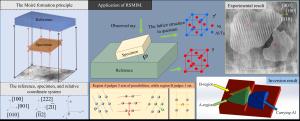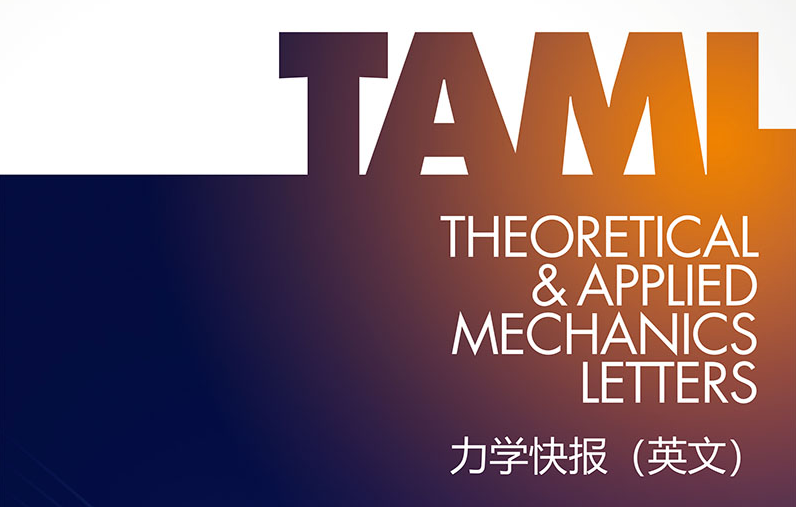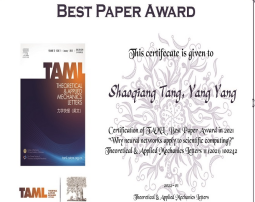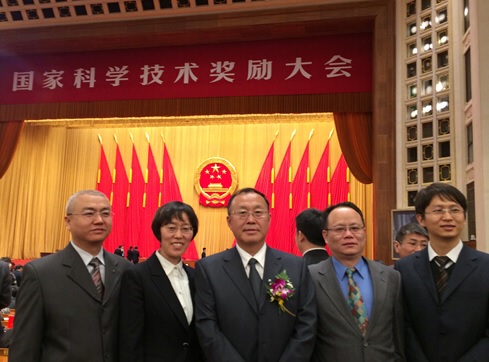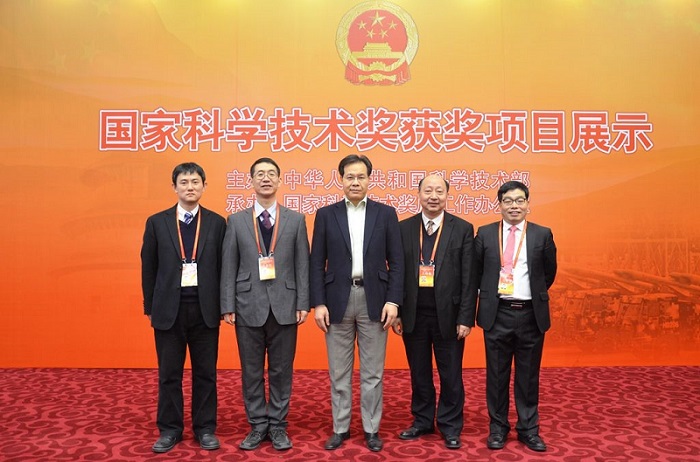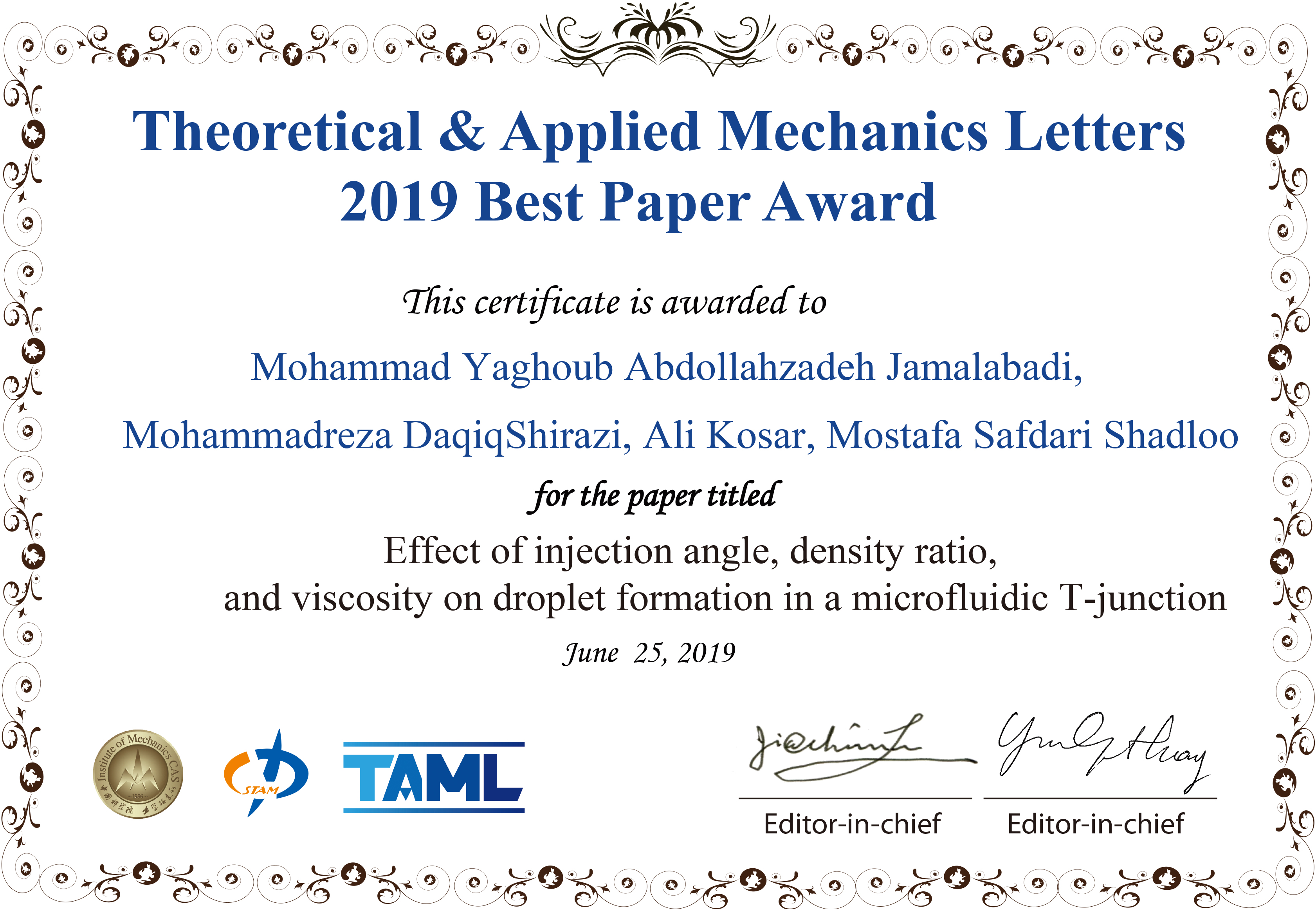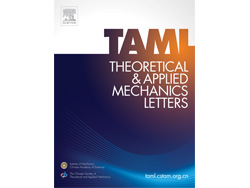Institute of Mechanics,
Chinese Academy of Sciences
2024 Vol.14(6)
Display Mode: |
Theoretical and Applied Mechanics Letters 14 (2024) 100518.
doi: 10.1016/j.taml.2024.100518
Abstract:
Distinct physical properties emerge at the nanoscale in Moiré materials, such as bilayer graphene and layered material superposition. This study explores similar structural features within a second-generation nickel-based superalloy, unveiling potential formation mechanisms. Introducing the real space Moiré inversion method (RSMIM) for nanoscale imaging, combined with the transmission electron microscopy (TEM) nano-Moiré inversion method, we reveal spatial angles between specimen and reference lattices in 3D. Simultaneously, we reconstruct the Moiré pattern region to deepen us understand the phenomenon of Moiré formation. Focused on face-centered cubic structures, the research identifies six spatial angles, shedding light on Moiré patterns in the superalloy. The RSMIM not only enhances understanding but also expands 3D structure measurement capabilities. The RSMIM served to validate TEM nano-Moiré inversion results, ascertaining the spatial relative angle between lattices, and establishing a theoretical simulation model for Moiré patterns. This study marks a substantial step toward designing high-performance nanomaterials by uncovering dynamic Moiré variations.
Distinct physical properties emerge at the nanoscale in Moiré materials, such as bilayer graphene and layered material superposition. This study explores similar structural features within a second-generation nickel-based superalloy, unveiling potential formation mechanisms. Introducing the real space Moiré inversion method (RSMIM) for nanoscale imaging, combined with the transmission electron microscopy (TEM) nano-Moiré inversion method, we reveal spatial angles between specimen and reference lattices in 3D. Simultaneously, we reconstruct the Moiré pattern region to deepen us understand the phenomenon of Moiré formation. Focused on face-centered cubic structures, the research identifies six spatial angles, shedding light on Moiré patterns in the superalloy. The RSMIM not only enhances understanding but also expands 3D structure measurement capabilities. The RSMIM served to validate TEM nano-Moiré inversion results, ascertaining the spatial relative angle between lattices, and establishing a theoretical simulation model for Moiré patterns. This study marks a substantial step toward designing high-performance nanomaterials by uncovering dynamic Moiré variations.
Theoretical and Applied Mechanics Letters 14 (2024) 100523.
doi: 10.1016/j.taml.2024.100523
Abstract:
The origami-based meta-structure has wide application in areas such as energy and wave transmission. Existing research has demonstrated the occurrence of supra-transmission in origami meta-structures and revealed its underlying mechanism. However, studies on how to regulate the phenomenon of supra-transmission are still very limited. In this work, we choose the meta-structure composed of stacked-Miura ori (SMO) as the subject. The SMO unit possesses two topologically distinct stable configurations, enabling the meta-structure to possess a rich variety of periodic layouts. Based on the established equivalent dynamic model of the SMO-based meta-structure, we employ numerical simulation methods and find that the supra-transmission threshold could be adjusted by tuning the periodic layout of the meta-structure. Furthermore, the probability of supra-transmission is also highly dependent on the periodic layout. Increasing the number of SMO units under the bulged-out configuration in each periodic layout decreases the likelihood of supratransmission occurring. The findings of this study yield an extensive array of foundational insights into the wave dynamics of origami structures. Furthermore, these insights translate into practical guidelines for designing origami-based meta-structure with tunable and programmable dynamic characteristics.
The origami-based meta-structure has wide application in areas such as energy and wave transmission. Existing research has demonstrated the occurrence of supra-transmission in origami meta-structures and revealed its underlying mechanism. However, studies on how to regulate the phenomenon of supra-transmission are still very limited. In this work, we choose the meta-structure composed of stacked-Miura ori (SMO) as the subject. The SMO unit possesses two topologically distinct stable configurations, enabling the meta-structure to possess a rich variety of periodic layouts. Based on the established equivalent dynamic model of the SMO-based meta-structure, we employ numerical simulation methods and find that the supra-transmission threshold could be adjusted by tuning the periodic layout of the meta-structure. Furthermore, the probability of supra-transmission is also highly dependent on the periodic layout. Increasing the number of SMO units under the bulged-out configuration in each periodic layout decreases the likelihood of supratransmission occurring. The findings of this study yield an extensive array of foundational insights into the wave dynamics of origami structures. Furthermore, these insights translate into practical guidelines for designing origami-based meta-structure with tunable and programmable dynamic characteristics.
Theoretical and Applied Mechanics Letters 14 (2024) 100524.
doi: 10.1016/j.taml.2024.100524
Abstract:
We present a series of large-eddy simulations to systematically investigate the impact of debris accumulation on the hydrodynamics and power production of a utility-scale marine hydrokinetic (MHK) turbine under various debris loads lodged on the upstream face of the turbine tower. The turbine blades are modeled using turbine resolving, actuator line, and actuator surface methods. Moreover, the influence of debris on the flow field is captured by directly resolving individual logs and employing a novel debris model. Analyzing the hydrodynamics effects of various debris accumulations, we show that an increase in the density of debris accumulation leads to more flow bypassing beneath the turbine blade. This, in turn, reduces the flow momentum that reaches the MHK blades at the lower depths, inducing significant fluctuation in power production. Further, it is shown that debris-induced turbulent fluctuations contribute to significant variability in the MHK turbine's power production.
We present a series of large-eddy simulations to systematically investigate the impact of debris accumulation on the hydrodynamics and power production of a utility-scale marine hydrokinetic (MHK) turbine under various debris loads lodged on the upstream face of the turbine tower. The turbine blades are modeled using turbine resolving, actuator line, and actuator surface methods. Moreover, the influence of debris on the flow field is captured by directly resolving individual logs and employing a novel debris model. Analyzing the hydrodynamics effects of various debris accumulations, we show that an increase in the density of debris accumulation leads to more flow bypassing beneath the turbine blade. This, in turn, reduces the flow momentum that reaches the MHK blades at the lower depths, inducing significant fluctuation in power production. Further, it is shown that debris-induced turbulent fluctuations contribute to significant variability in the MHK turbine's power production.
Theoretical and Applied Mechanics Letters 14 (2024) 100525.
doi: 10.1016/j.taml.2024.100525
Abstract:
Interfacial polarization dominates the permittivity spectra of heterogeneous granular materials for the intermediate frequency range (i.e., from kHz to MHz). In this study, we examine the corresponding dielectric responses of compacted glass sphere packings saturated with pore-filling fluids under various compressive stresses. The effective permittivity spectra are observed to exhibit consistently a plateau-to-plateau drop, described by low-frequency permittivity, characteristic frequency, and high-frequency permittivity. The permittivity spectra under different compressive levels are found to be influenced by the packing structure, compressive stress, and electrical property contrasts between solid and fluid (specifically permittivity and conductivity). For considered measurement conditions, the variation of packing structure and its associated porosity is found to be more significant than the stress evolution in controlling the interfacial polarization, thus the permittivity spectra, as supported by analytical and numerical results for unit cells. Furthermore, to gain a general rule for dielectric responses for saturated granular materials, we train multi-layer artificial neural network (ANN) models based on a series of simulations for unit cells with various structures, stresses, and electrical and dielectric properties. The predictions with two-layer ANN agree well with experimental measurements, presenting errors smaller than 5% for both low-frequency and high-frequency permittivity. This study offers an effective predicting approach for the dielectric behaviour of heterogeneous and multiphase materials.
Interfacial polarization dominates the permittivity spectra of heterogeneous granular materials for the intermediate frequency range (i.e., from kHz to MHz). In this study, we examine the corresponding dielectric responses of compacted glass sphere packings saturated with pore-filling fluids under various compressive stresses. The effective permittivity spectra are observed to exhibit consistently a plateau-to-plateau drop, described by low-frequency permittivity, characteristic frequency, and high-frequency permittivity. The permittivity spectra under different compressive levels are found to be influenced by the packing structure, compressive stress, and electrical property contrasts between solid and fluid (specifically permittivity and conductivity). For considered measurement conditions, the variation of packing structure and its associated porosity is found to be more significant than the stress evolution in controlling the interfacial polarization, thus the permittivity spectra, as supported by analytical and numerical results for unit cells. Furthermore, to gain a general rule for dielectric responses for saturated granular materials, we train multi-layer artificial neural network (ANN) models based on a series of simulations for unit cells with various structures, stresses, and electrical and dielectric properties. The predictions with two-layer ANN agree well with experimental measurements, presenting errors smaller than 5% for both low-frequency and high-frequency permittivity. This study offers an effective predicting approach for the dielectric behaviour of heterogeneous and multiphase materials.
Theoretical and Applied Mechanics Letters 14 (2024) 100526.
doi: 10.1016/j.taml.2024.100526
Abstract:
A two-scale method is proposed to simulate the essential behavior of bolted connections in structures including elevated temperatures. It is presented, verified, and validated for the structural behavior of two plates, connected by a bolt, under a variety of loads and elevated temperatures. The method consists of a global-scale model that simulates the structure (here the two plates) by volume finite elements, and in which the bolt is modelled by a spring. The spring properties are provided by a small-scale model, in which the bolt is modelled by volume elements, and for which the boundary conditions are retrieved from the global-scale model. To ensure the small-scale model to be as computationally efficient as possible, simplifications are discussed regarding the material model and the modelling of the threads. For the latter, this leads to the experimentally validated application of a non-threaded shank with its stress area. It is shown that a non-linear elastic spring is needed for the bolt in the global-scale model, so the post-peak behavior of the structure can be described efficiently. All types of bolted connection failure as given by design standards are simulated by the two-scale method, which is successfully validated (except for net section failure) by experiments, and verified by a detailed system model, which models the structure in full detail. The sensitivity to the size of the part of the plate used in the small-scale model is also studied. Finally, multi-directional load cases, also for elevated temperatures, are studied with the two-scale method and verified with the detailed system model. As a result, a computationally efficient finite element modelling approach is provided for all possible combined load actions (except for nut thread failure and net section failure) and temperatures. The two-scale method is shown to be insightful, for it contains a functional separation of scales, revealing their relationships, and consequently, local small-scale non-convergence can be handled. Not presented in this paper, but the two-scale method can be used in e.g. computationally expensive two-way coupled fire-structure simulations, where it is beneficial for distributed computing and densely packed bolt configurations with stiff plates, for which a single small-scale model may be representative of several connections.
A two-scale method is proposed to simulate the essential behavior of bolted connections in structures including elevated temperatures. It is presented, verified, and validated for the structural behavior of two plates, connected by a bolt, under a variety of loads and elevated temperatures. The method consists of a global-scale model that simulates the structure (here the two plates) by volume finite elements, and in which the bolt is modelled by a spring. The spring properties are provided by a small-scale model, in which the bolt is modelled by volume elements, and for which the boundary conditions are retrieved from the global-scale model. To ensure the small-scale model to be as computationally efficient as possible, simplifications are discussed regarding the material model and the modelling of the threads. For the latter, this leads to the experimentally validated application of a non-threaded shank with its stress area. It is shown that a non-linear elastic spring is needed for the bolt in the global-scale model, so the post-peak behavior of the structure can be described efficiently. All types of bolted connection failure as given by design standards are simulated by the two-scale method, which is successfully validated (except for net section failure) by experiments, and verified by a detailed system model, which models the structure in full detail. The sensitivity to the size of the part of the plate used in the small-scale model is also studied. Finally, multi-directional load cases, also for elevated temperatures, are studied with the two-scale method and verified with the detailed system model. As a result, a computationally efficient finite element modelling approach is provided for all possible combined load actions (except for nut thread failure and net section failure) and temperatures. The two-scale method is shown to be insightful, for it contains a functional separation of scales, revealing their relationships, and consequently, local small-scale non-convergence can be handled. Not presented in this paper, but the two-scale method can be used in e.g. computationally expensive two-way coupled fire-structure simulations, where it is beneficial for distributed computing and densely packed bolt configurations with stiff plates, for which a single small-scale model may be representative of several connections.
Theoretical and Applied Mechanics Letters 14 (2024) 100527.
doi: 10.1016/j.taml.2024.100527
Abstract:
Transformer has achieved remarkable results in various fields, including its application in modeling dynamic systems governed by partial differential equations. However, transformer still face challenges in achieving long-term stable predictions for three-dimensional turbulence. In this paper, we propose an implicit factorized transformer (IFactFormer) model, which enables stable training at greater depths through implicit iteration over factorized attention. IFactFormer is applied to large eddy simulation of three-dimensional homogeneous isotropic turbulence (HIT), and is shown to be more accurate than the FactFormer, Fourier neural operator (FNO), and dynamic Smagorinsky model (DSM) in the prediction of the velocity spectra, probability density functions of velocity increments and vorticity, temporal evolutions of velocity and vorticity root-mean-square value and isosurface of the normalized vorticity. IFactFormer can achieve long-term stable predictions of a series of turbulence statistics in HIT. Furthermore, IFactFormer showcases superior computational efficiency compared to the conventional DSM in large eddy simulation.
Transformer has achieved remarkable results in various fields, including its application in modeling dynamic systems governed by partial differential equations. However, transformer still face challenges in achieving long-term stable predictions for three-dimensional turbulence. In this paper, we propose an implicit factorized transformer (IFactFormer) model, which enables stable training at greater depths through implicit iteration over factorized attention. IFactFormer is applied to large eddy simulation of three-dimensional homogeneous isotropic turbulence (HIT), and is shown to be more accurate than the FactFormer, Fourier neural operator (FNO), and dynamic Smagorinsky model (DSM) in the prediction of the velocity spectra, probability density functions of velocity increments and vorticity, temporal evolutions of velocity and vorticity root-mean-square value and isosurface of the normalized vorticity. IFactFormer can achieve long-term stable predictions of a series of turbulence statistics in HIT. Furthermore, IFactFormer showcases superior computational efficiency compared to the conventional DSM in large eddy simulation.
Theoretical and Applied Mechanics Letters 14 (2024) 100528.
doi: 10.1016/j.taml.2024.100528
Abstract:
Kirigami metamaterials have gained increasing attention due to their unusual mechanical properties under large stretching. However, most metamaterial designs obtained with trial-and-error approaches tend to lose their desirable properties under large tensile strains due to occurrence of instability caused by out-of-plane buckling. To cope with this limitation, this paper presents a systematic approach of cut layout optimizing for designing kirigami metamaterials working at large tensile strains by fully exploiting their out-of-plane buckling behaviors. This method can also mitigate the local stress concentration issue at the hinges of conventional kirigami designs working at in-plane deformation modes. The effectiveness of the proposed method is demonstrated through several examples regarding metamaterial design with negative Poisson's ratio and specified flip angle pattern. It is shown that the proposed method is capable of addressing the highly nonlinear deformation impacts on the mechanical performance under large stretching, to meet the growing and diverse demands in the field of kirigami metamaterials.
Kirigami metamaterials have gained increasing attention due to their unusual mechanical properties under large stretching. However, most metamaterial designs obtained with trial-and-error approaches tend to lose their desirable properties under large tensile strains due to occurrence of instability caused by out-of-plane buckling. To cope with this limitation, this paper presents a systematic approach of cut layout optimizing for designing kirigami metamaterials working at large tensile strains by fully exploiting their out-of-plane buckling behaviors. This method can also mitigate the local stress concentration issue at the hinges of conventional kirigami designs working at in-plane deformation modes. The effectiveness of the proposed method is demonstrated through several examples regarding metamaterial design with negative Poisson's ratio and specified flip angle pattern. It is shown that the proposed method is capable of addressing the highly nonlinear deformation impacts on the mechanical performance under large stretching, to meet the growing and diverse demands in the field of kirigami metamaterials.
Theoretical and Applied Mechanics Letters 14 (2024) 100529.
doi: 10.1016/j.taml.2024.100529
Abstract:
In this letter, the motion of small gas bubbles within sessile water drops on a vibrating substrate is investigated numerically using a two-phase diffuse interface method. Depending on the amplitude of the plate vibration, the motion of the gas bubbles falls into three distinct regimes: oscillating within the drop, sticking to the substrate, or escaping from the drop. In particular, the motion of oscillating bubbles follows a harmonic function, and is found to be closely related to a combined effect of the deformation of the sessile drop and the vibration of the plate. To interpret the underlying mechanism, we analyze the dominant forces acting on the bubbles in the non-inertial framework fixed to the plate, and take account of the periodic deformation of the drop, which effectively induces flow acceleration inside the drop. As a result, we establish a theoretical model to predict the bubble motion, and correlate the amplitude and phase difference of the bubble with the Bond and Strouhal numbers. The theoretical prediction agrees with our numerical results. These findings and theoretical analysis provide new insights into controlling bubble motion in sessile drops.
In this letter, the motion of small gas bubbles within sessile water drops on a vibrating substrate is investigated numerically using a two-phase diffuse interface method. Depending on the amplitude of the plate vibration, the motion of the gas bubbles falls into three distinct regimes: oscillating within the drop, sticking to the substrate, or escaping from the drop. In particular, the motion of oscillating bubbles follows a harmonic function, and is found to be closely related to a combined effect of the deformation of the sessile drop and the vibration of the plate. To interpret the underlying mechanism, we analyze the dominant forces acting on the bubbles in the non-inertial framework fixed to the plate, and take account of the periodic deformation of the drop, which effectively induces flow acceleration inside the drop. As a result, we establish a theoretical model to predict the bubble motion, and correlate the amplitude and phase difference of the bubble with the Bond and Strouhal numbers. The theoretical prediction agrees with our numerical results. These findings and theoretical analysis provide new insights into controlling bubble motion in sessile drops.
Theoretical and Applied Mechanics Letters 14 (2024) 100531.
doi: 10.1016/j.taml.2024.100531
Abstract:
A new cyclic cohesive zone fatigue damage model is proposed to address the fatigue problem spanning high and low cycle stages. The new damage model is integrated with the damage extrapolation technique to improve calculation efficiency. The model's effectiveness in regulating the low-cycle fatigue evolution rate, overall fatigue damage evolution rate, and stress level at the fatigue turning point is assessed through the comparison of the S-N curves. The fatigue damage model's high precision is proved based on the minor deviation of stress at the turning point of the S-N curve from the actual scenario. Finally, the fatigue damage evolution is simulated considering the effects of pre-load pressure and welding residual stress. It is observed that laser welding induces a significant residual tensile stress, accelerating fatigue damage evolution, while compressive loading impedes fatigue damage progression.
A new cyclic cohesive zone fatigue damage model is proposed to address the fatigue problem spanning high and low cycle stages. The new damage model is integrated with the damage extrapolation technique to improve calculation efficiency. The model's effectiveness in regulating the low-cycle fatigue evolution rate, overall fatigue damage evolution rate, and stress level at the fatigue turning point is assessed through the comparison of the S-N curves. The fatigue damage model's high precision is proved based on the minor deviation of stress at the turning point of the S-N curve from the actual scenario. Finally, the fatigue damage evolution is simulated considering the effects of pre-load pressure and welding residual stress. It is observed that laser welding induces a significant residual tensile stress, accelerating fatigue damage evolution, while compressive loading impedes fatigue damage progression.
Theoretical and Applied Mechanics Letters 14 (2024) 100532.
doi: 10.1016/j.taml.2024.100532
Abstract:
Bistable curved shells have become a promising low-cost application in energy absorption fields owing to recent advances in material and technology. Significant research has been conducted to improve their energy absorption effect through forward prediction and singleobjective optimization. However, these approaches may not fully explore their functional potential. In this study, we propose a multi-objective optimization framework based on the principle of main objective optimization that combines neural networks and genetic algorithms. The energy absorption effect and backward snapping force of the bistable curved shell are improved synchronously. Meanwhile, a reverse design algorithm is developed to generate the preset load-displacement curve, which further expands the application of machine learning methods in the field of multi-objective optimization. The combination of machine learning and multi-objective optimization is highly effective for building meta-structures with specific performance requirements and has potential applications in solving complex optimization tasks in various fields.
Bistable curved shells have become a promising low-cost application in energy absorption fields owing to recent advances in material and technology. Significant research has been conducted to improve their energy absorption effect through forward prediction and singleobjective optimization. However, these approaches may not fully explore their functional potential. In this study, we propose a multi-objective optimization framework based on the principle of main objective optimization that combines neural networks and genetic algorithms. The energy absorption effect and backward snapping force of the bistable curved shell are improved synchronously. Meanwhile, a reverse design algorithm is developed to generate the preset load-displacement curve, which further expands the application of machine learning methods in the field of multi-objective optimization. The combination of machine learning and multi-objective optimization is highly effective for building meta-structures with specific performance requirements and has potential applications in solving complex optimization tasks in various fields.
Theoretical and Applied Mechanics Letters 14 (2024) 100533.
doi: 10.1016/j.taml.2024.100533
Abstract:
Droplet levitation and coalescence mechanisms have consistently been a focal point in scientific research. From the perspective of molecular interactions, we investigated the influence of vapor pressure on the levitation and coalescence of droplets. The evaporation of nanodroplets and liquid pools under different initial environments was simulated by nonequilibrium molecular dynamics. The study analyzed the effects of evaporation during the processes of droplet levitation and coalescence and determined the existence of the Knudsen layer. Knudsen layers consisting of water molecules rather than clusters are generated during the evaporation. The definition, properties, and mechanisms of the layers were investigated.
Droplet levitation and coalescence mechanisms have consistently been a focal point in scientific research. From the perspective of molecular interactions, we investigated the influence of vapor pressure on the levitation and coalescence of droplets. The evaporation of nanodroplets and liquid pools under different initial environments was simulated by nonequilibrium molecular dynamics. The study analyzed the effects of evaporation during the processes of droplet levitation and coalescence and determined the existence of the Knudsen layer. Knudsen layers consisting of water molecules rather than clusters are generated during the evaporation. The definition, properties, and mechanisms of the layers were investigated.
Theoretical and Applied Mechanics Letters 14 (2024) 100536.
doi: 10.1016/j.taml.2024.100536
Abstract:
The layered nature of the parts produced by 3D printing makes them susceptible to freezethaw damage. This research investigates the effect of the freeze-thaw cycles on the tensile, bending, and fracture resistance of samples made of Polylactic acid (PLA) material. For this purpose, the samples with 100, 75, 50, and 25 infill percentages were subjected to 4, 8, and 12 freeze-thaw cycles. The results show that the infill percentage and cycle affect freeze-thaw resistance. So, although for 100% infill samples, the 4, 8, and 12 cycles averagely reduce the tensile strength by 5, 15, and 25. The same trends can also be seen for flexural strength and, more severely, fracture resistance. Reviewing the microstructure with a Scanning electron microscopy (SEM) device shows freeze-thaw’s destructive effect (both the strand’s surface and their joints). In the end, simple statistical analyses were presented to evaluate a model for anticipating the effect of freeze-thaw on mechanical resistance.
The layered nature of the parts produced by 3D printing makes them susceptible to freezethaw damage. This research investigates the effect of the freeze-thaw cycles on the tensile, bending, and fracture resistance of samples made of Polylactic acid (PLA) material. For this purpose, the samples with 100, 75, 50, and 25 infill percentages were subjected to 4, 8, and 12 freeze-thaw cycles. The results show that the infill percentage and cycle affect freeze-thaw resistance. So, although for 100% infill samples, the 4, 8, and 12 cycles averagely reduce the tensile strength by 5, 15, and 25. The same trends can also be seen for flexural strength and, more severely, fracture resistance. Reviewing the microstructure with a Scanning electron microscopy (SEM) device shows freeze-thaw’s destructive effect (both the strand’s surface and their joints). In the end, simple statistical analyses were presented to evaluate a model for anticipating the effect of freeze-thaw on mechanical resistance.
Theoretical and Applied Mechanics Letters 14 (2024) 100557.
doi: 10.1016/j.taml.2024.100557
Abstract:
Particle image velocimetry and numerical simulation results of juncture flows were analyzed to parametrically investigate topology transition. The vortex system evolutions from non-vortex to multi-vortex with variations in obstacle bluntness, obstacle width, flow velocity and boundary layer thickness are discussed from the perspective of velocity characteristic lines. The velocity characteristic lines of u = 0, v = 0, and ▽2v = 0 are adopted to describe the vortex system evolution. The motions of the characteristic lines with juncture flow parameters are described in detail, and the corresponding reflections of the vortex system patterns are illustrated. A panoramic picture of the development of velocity characteristic lines corresponding to the HSV topology transition from a non-vortex to a multi-vortex system with variations in the juncture flow parameter is established. Two methods for determining the attachment/separation pattern of the most upstream singularity are proposed. One method is based on the number of intersections of the u = 0 and v = 0 velocity characteristic curve lines, and the other is based on the relative positions of the most upstream feet of the u = 0 and v = 0 loop curves with both feet attached to the wall.
Particle image velocimetry and numerical simulation results of juncture flows were analyzed to parametrically investigate topology transition. The vortex system evolutions from non-vortex to multi-vortex with variations in obstacle bluntness, obstacle width, flow velocity and boundary layer thickness are discussed from the perspective of velocity characteristic lines. The velocity characteristic lines of u = 0, v = 0, and ▽2v = 0 are adopted to describe the vortex system evolution. The motions of the characteristic lines with juncture flow parameters are described in detail, and the corresponding reflections of the vortex system patterns are illustrated. A panoramic picture of the development of velocity characteristic lines corresponding to the HSV topology transition from a non-vortex to a multi-vortex system with variations in the juncture flow parameter is established. Two methods for determining the attachment/separation pattern of the most upstream singularity are proposed. One method is based on the number of intersections of the u = 0 and v = 0 velocity characteristic curve lines, and the other is based on the relative positions of the most upstream feet of the u = 0 and v = 0 loop curves with both feet attached to the wall.
Theoretical and Applied Mechanics Letters 14 (2024) 100558.
doi: 10.1016/j.taml.2024.100558
Abstract:
Rock burst is a kind of severe engineering disaster resulted from dynamic fracture process of rocks. The macro failure behaviors of rocks are primarily formed after experiencing the initiation, propagation, and coalescence of micro-cracks. In this paper, the grain-based discretized virtual internal bond model is employed to investigate the fracturing process of unloaded rock under high in-situ stresses from the micro-fracture perspective. The simulated micro-fracturing process reveals that the longitudinal stress waves induced by unloading lead to the visible unloading effect. The influences of in-situ stresses, mineral grain sizes, and grain heterogeneity on rock macro and micro fracture are investigated. Micro-crack areas of tensile and shear cracks and micro-crack angles are statistically analyzed to reveal the rock micro-fracture characteristics. The simulated results indicate that the combined effect of the stress state transition and the unloading effect dominates the rock unloading failure. The vertical and horizontal in-situ stresses determine the stress state of surrounding rock after unloading and the unloading effect, respectively. As the vertical stress increases, the stress level after unloading is higher, and the shear failure characteristics become more obvious. As the horizontal stress increases, the unloading effect increases, leading to the intensification of tensile failure. The mineral grain size and grain heterogeneity also have nonnegligible influences on rock unloading failure. The micro-fracture perspective provides further insight into the unloading failure mechanism of deep rock excavation.
Rock burst is a kind of severe engineering disaster resulted from dynamic fracture process of rocks. The macro failure behaviors of rocks are primarily formed after experiencing the initiation, propagation, and coalescence of micro-cracks. In this paper, the grain-based discretized virtual internal bond model is employed to investigate the fracturing process of unloaded rock under high in-situ stresses from the micro-fracture perspective. The simulated micro-fracturing process reveals that the longitudinal stress waves induced by unloading lead to the visible unloading effect. The influences of in-situ stresses, mineral grain sizes, and grain heterogeneity on rock macro and micro fracture are investigated. Micro-crack areas of tensile and shear cracks and micro-crack angles are statistically analyzed to reveal the rock micro-fracture characteristics. The simulated results indicate that the combined effect of the stress state transition and the unloading effect dominates the rock unloading failure. The vertical and horizontal in-situ stresses determine the stress state of surrounding rock after unloading and the unloading effect, respectively. As the vertical stress increases, the stress level after unloading is higher, and the shear failure characteristics become more obvious. As the horizontal stress increases, the unloading effect increases, leading to the intensification of tensile failure. The mineral grain size and grain heterogeneity also have nonnegligible influences on rock unloading failure. The micro-fracture perspective provides further insight into the unloading failure mechanism of deep rock excavation.
 Submit a Paper
Submit a Paper
 Subscription
Subscription
News
MORE+
Call for Papers
MORE+
- Crossing-Mechanics Driven by Big Data
- Machine learning in the fluid mechanics research of wind energy
- Mechanics of Origami/Kirigami structures and metamaterials
- New insights and perspectives on impact biomechanics for human tissues: from injury prevention, protection to protective equipment
- Environmental Mechanics for Extreme Natural Events



